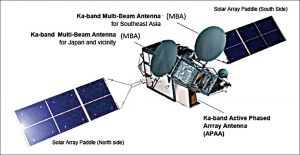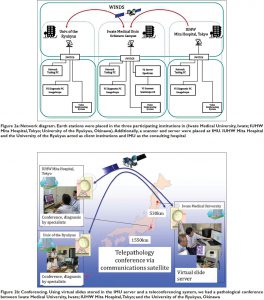Study: World’s first telepathology experiments employing WINDS ultra-high-speed internet satellite, nicknamed “KIZUNA”
 World’s first telepathology experiments employing WINDS ultra-high-speed internet satellite, nicknamed “KIZUNA”
World’s first telepathology experiments employing WINDS ultra-high-speed internet satellite, nicknamed “KIZUNA”
Sawai T, Uzuki M, Miura Y, Kamataki A, Matsumura T, Saito K, Kurose A, Osamura YR, Yoshimi N, Kanno H, Moriya T, Ishida Y, Satoh Y, Nakao M, Ogawa E, Matsuo S, Kasai H, Kumagai K, Motoda T , Hopson N
Division of Leading Pathophysiology, Department of Pathology, School of Medicine, Iwate Medical University, Yahaba, Japan.
ABSTRACT:
 BACKGROUND: Recent advances in information technology have allowed the development of a telepathology system involving high-speed transfer of high-volume histological figures via fiber optic landlines. However, at present there are geographical limits to landlines. The Japan Aerospace Exploration Agency (JAXA) has developed the “Kizuna” ultra-high speed internet satellite and has pursued its various applications. In this study we experimented with telepathology in collaboration with JAXA using Kizuna. To measure the functionality of the Wideband InterNet working engineering test and Demonstration Satellite (WINDS) ultra-high speed internet satellite in remote pathological diagnosis and consultation, we examined the adequate data transfer speed and stability to conduct telepathology (both diagnosis and conferencing) with functionality, and ease similar or equal to telepathology using fiber-optic landlines.
BACKGROUND: Recent advances in information technology have allowed the development of a telepathology system involving high-speed transfer of high-volume histological figures via fiber optic landlines. However, at present there are geographical limits to landlines. The Japan Aerospace Exploration Agency (JAXA) has developed the “Kizuna” ultra-high speed internet satellite and has pursued its various applications. In this study we experimented with telepathology in collaboration with JAXA using Kizuna. To measure the functionality of the Wideband InterNet working engineering test and Demonstration Satellite (WINDS) ultra-high speed internet satellite in remote pathological diagnosis and consultation, we examined the adequate data transfer speed and stability to conduct telepathology (both diagnosis and conferencing) with functionality, and ease similar or equal to telepathology using fiber-optic landlines.
MATERIALS AND METHODS: We performed experiments for 2 years. In year 1, we tested the usability of the WINDS for telepathology with real-time video and virtual slide systems. These are state-of-the-art technologies requiring massive volumes of data transfer. In year 2, we tested the usability of the WINDS for three-way teleconferencing with virtual slides. Facilities in Iwate (northern Japan), Tokyo, and Okinawa were connected via the WINDS and voice conferenced while remotely examining and manipulating virtual slides.
RESULTS: Network function parameters measured using ping and Iperf were within acceptable limits. However; stage movement, zoom, and conversation suffered a lag of approximately 0.8 s when using real-time video, and a delay of 60-90 s was experienced when accessing the first virtual slide in a session. No significant lag or inconvenience was experienced during diagnosis and conferencing, and the results were satisfactory. Our hypothesis was confirmed for both remote diagnosis using real-time video and virtual slide systems, and also for teleconferencing using virtual slide systems with voice functionality.
CONCLUSIONS: Our results demonstrate the feasibility of ultra-high-speed internet satellite networks for use in telepathology. Because communications satellites have less geographical and infrastructural requirements than landlines, ultra-high-speed internet satellite telepathology represents a major step toward alleviating regional disparity in the quality of medical care.

































